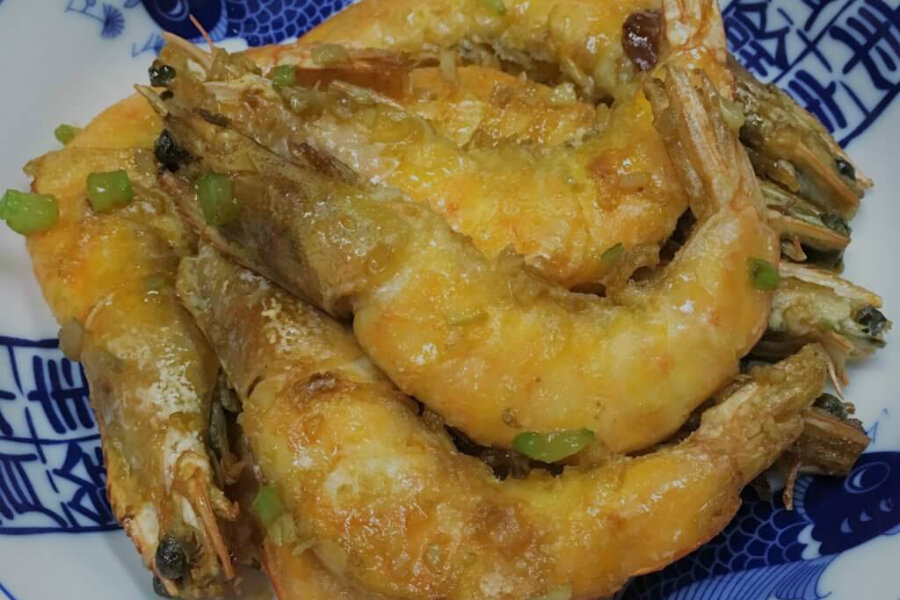Chinese New Year panfried shrimp
Loading...
Over the years, I’ve learned a lot about the food traditions of other Asian cultures, especially during Lunar or Chinese New Year.
The Vietnamese, who celebrate Tet, celebrate with a host of different foods like banh chung, thit kho, candied fruit and lots of pickles.
In Singapore, raw fish salad (yu sheng) is very popular. The Taiwanese eat sweet dumplings in red bean soup, and Indonesians have their own version of pineapple “tarts,” sweet pineapple jam encased in a crumbly shortcrust pastry.
I grew up following the same ole, same ole new year food customs so I’m always (pleasantly) surprised when I learn that other Chinese families have somewhat different customs and traditions.
Recently, I met Wendy Kiang-Spray, a Master Gardener who specializes in growing Asian vegetables and cookbook author in the D.C. area. Like many Chinese families, her family always has dumplings on the table for Chinese New Year.
More often than not, the women and girls in the family make the dumplings. But in Wendy’s family, her dad is the master dumpling-maker. Instead of just the usual pork and Chinese (Napa) cabbage combination, Wendy’s dad stuffs his dumplings with an extra-special ingredient as well–crab meat. And for old time’s sake, he still follows the tradition of hiding coins in the dumplings. “Whoever finds them is said to have good luck for the rest of the year!” Wendy says. (You’ll have to buy Wendy’s cookbook "The Chinese Kitchen Garden" for her dad’s crab dumpling recipe reveal!)
Chinese New Year foods often comprise dishes that are homonyms for lucky words and phrases and/or symbols of good luck, prosperity and health. Wendy says there is always a shrimp dish because the word for shrimp, ‘ha’ in Cantonese, is a homophone for ‘ha ha’ as in laughter and ‘ha ha siu’ means “ha ha smile.” Who doesn’t want to be happy in the new year?
Sometimes, Wendy’s mom will make a shrimp dish with tomato sauce because the color red is very auspicious. “Red in Cantonese is ‘houng,’ a homonym for fortune,” explains Wendy.
Her mom also likes to use certain lucky numbers, says Wendy. “In this dish, she will usually serve the shrimp in quantities of eight or 18 depending on the size of her party. Eight is pronounced ‘baht’ in Cantonese, and fortune is pronounced similarly, ‘faht.’”
Everyone has their own interpretations right? Won’t you share yours below?
No matter what you’re having for Lunar or Chinese New Year, I wish you a happy, healthy and prosperous Year of the Rooster! Xing Nian Kuai Le! Gong Xi Fa Cai!
Chinese New Year panfried shrimp
By Wendy Kiang-Spray
18 jumbo head- and tail-on shrimp
1 tablespoon soy sauce
1/2 tablespoon sugar
1 teaspoon Shaoxing Chinese wine
1/4 cup cornstarch
½-inch chunk of ginger, cut into a few slices
1 stalk Chinese celery, finely chopped
1 shallot, finely chopped
2 cloves garlic, minced
Vegetable oil, such as corn or sunflower oil, for fryingInstructions
- To prepare shrimp: snip the heads up to the eyes with kitchen shears. Snip and remove the legs. Devein. Rinse and pat dry thoroughly to prevent oil from splattering later.
- Sprinkle both sides of shrimp with cornstarch.
- In a small dish, mix the soy sauce, sugar and wine.
- Heat 3 tablespoons of oil in a wok or frying pan. Add ginger and swirl around for a minute to flavor oil. In batches, pan fry shrimp on both sides for a few minutes until pink, slightly curled and cooked through. Remove shrimp and set aside.
- Wipe down pan with a paper towel. Add another 1 tablespoon oil to wok. Add shallots, celery and garlic. Stir for a minute or two until fragrant. Add shrimp and sauce to wok. Stir until hot and serve.
Notes
- Chinese celery's flavor is more intense than Western celery and can be found at Asian markets. Substitute with regular celery.
Related post on Pickles and Tea: Eating Silver and Gold–Chinese New Year Dumplings








